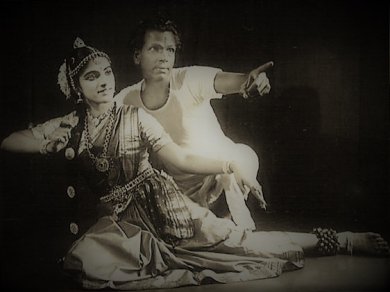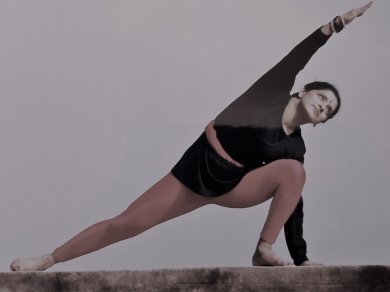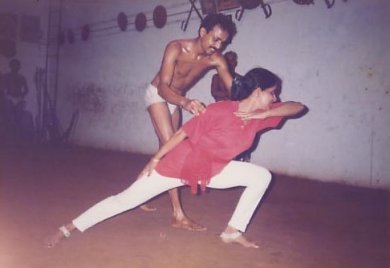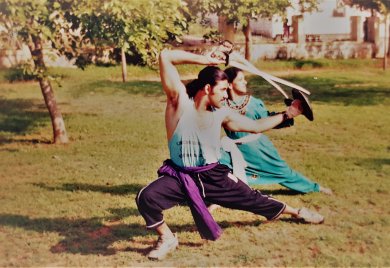
|   |

|   |
Biography by Prof George S Paul - Dr. Sunil Kothari e-mail: sunilkothari1933@gmail.com November 12, 2019 On the occasion of the 70th birthday of senior Mysore based Bharatanatyam exponent Dr. Vasundhara Doraswamy, her biography Vasundhara: Odyssey of a Dancer penned by Prof George S Paul was released on 2nd November in Mysore during the celebrations. Prof George S Paul is a recognized authority on Indian classical music and dance. Based in Thrissur, he was a Professor of Physics and has a long career as arts journalist and critic. What is interesting about this biography is that it deals with the life of a dancer born in backwaters of Moodabidri-Mangalore, who by sheer grit, determination and complete support from her parents and her husband Mr. Doraswamy, an art connoisseur from Mysore, 20 years older than her, who was determined to make her a top dancer in field of Bharatanatyam. The author has a distinct advantage, being a close friend of Mr. Doraswamy and his cousin T.N. Harish, so he could elicit many personal anecdotes which make the narrative extremely interesting. The author being also an ace program organizer has enough knowledge and experience of the various hazards the organizers, dancer and her musicians face on various occasions. Vasundhara was born on 1st November 1949 at Moodabidri to a well-to-do family where her parents were interested in classical music and dance. Three sons and two daughters including Vasundhara were encouraged to learn music. Dance happened in case of Vasundhara. Fortunately, one teacher by name Muralidhar Rao was available with enough knowledge of dance, in particular Kathakali, and some popular dance movements. As a child, Vasundhara studied some Kathakali and popular style of dance and used to perform at various school events. That she was mad about learning dance was obvious to her parents. They wanted her to study Bharatanatyam. It so happened that there was another teacher Salem Rajaratnam Pillai who was conducting classes in Bharatanatyam at Shornur. Muralidhar Rao approached him to train Vasundhara in Bharatanatyam. Salem Rajaratnam Pillai had studied directly under Pandanallur Meenakshisundaram Pillai. After several requests he agreed to come to Moodabidri and taught Vasundhara, with the result that she got strong foundation in Pandanallur bani. Along with her studies in school, her performances for several dance competitions were taking place regularly. She went on winning prizes after prizes. Her fame also reached connoisseurs in Mysore. Now the story looks like one from a fairy tale. The art connoisseur Mr. Doraswamy came to know of this child prodigy. His own interest was in classical Hindustani music, Carnatic music, and Western classical music. He was a close friend of sitar maestro Ustad Abdul Halim Jaffer Khan. Doraswamy was known to the author and both shared their love for Western classical music. As a matter of fact, George has written a book explaining intricacies of 'raga' system comparing with the intricacies of harmony of the Western classical music on the basis of physics. Doraswamy, whom the author refers to throughout the biography as Dore, listened to classical Western music on foreign radio stations and cultivated taste for Western music. Belonging to well-to-do family with enough monetary support, he did not have to earn money and devoted all time to listening to classical music of various genres and led a happy life. The news of Vasundhara reached him and he decided to see her. Visiting Moodabidri, he found that Vasundhara indeed was a bright dancer with a star quality. He decided to launch her as a brilliant dancer, but moving to Mysore was not easy for Vasundhara. Now stepped in the sitar maestro Abdul Halim Jaffer Khan, who knowing Dore's obsession, suggested that he marry the young dancer. The difference in age did not matter. Vasundhara's passion for dance was the ultimate acid test. After many consultations and comparing horoscopes, once they found they matched, the parents agreed in spite of the age difference for their marriage. Coming to Mysore in different background and different set up of a family, Vasundhara found it difficult to adjust in the beginning. But Dore took care of her. His mother took kindly to her daughter-in-law, but she was conservative in some aspects. However, Vasundhara won her mother-in-law over and her career as a dancer was launched. Once, when she was all ready to go on stage to perform for an important event for which Dore had invited important people as chief guests and the tickets were also sold out, his mother passed away. It was a moment which demanded that the show must be cancelled. But Dore with great restrain kept his personal agony under control, insisted that the show must go on and prevailed upon Vasundhara to perform. "The show must go on" was his determination. With a heavy heart Vasundhara performed and none knew that she was dancing under great mental strain. After the show she fainted in the green room backstage. The VIPs wanted to compliment her after the show but had to place the flowers they had brought for her at her feet! In the chapter on 'Trials and Tribulations,' we learn that Dore's financial condition met with reverses. Also by then, Vasundhara had a son two years old. Dore sold his bungalow and they had to move into a small apartment. But Dore did not seem to worry and left everything to Vasundhara to manage, including his own personal comforts and requirements. Vasundhara was fighting against several obstacles and often felt like committing suicide. But one look at her two year old son, she decided to fight and meet all the challenges to carry on her life as a dancer.  Vasundhara with Guru Muralidhar Rao  Vasundhara in Yoga pose Dore had established Vasundhara Performing Arts Centre and also arranged annual festivals. Abdul Halim Jaffer Khan had encouraged him to do so. Vasundhara started teaching young girls and soon her class swelled with a number of students and she was able to meet the financial crisis, even when Dore did not make any attempt to earn. Since the invitations came aplenty for performances, Dore helped her to perform as best as she could. At her residence in Saraswathipuram, once her old guru Muralidhar Rao turned up and since he was unwell, Vasundhara and Dore allowed him to stay. But they found out that while he was staying there, he was running parallel classes and was trying to take away Vasundhara's disciples also. He was therefore shown the door. But after many years when his name was to be recommended for some award, Vasundhara being on the committee recommended her guru's name. She was very proud when he got the award. Her other guru Salem Rajaratnam Pillai also came to see her and was extremely pleased seeing her progress. He wrote to her about his appreciation mentioning that he had found her to be the best student in Pandanallur bani. Another facet of Vasundhara's life we learn in chapter 'Career and Corpus of work'. Her Yoga teacher was Sri Pattabhi Jois. An internationally renowned Yoga expert, under who singer Madonna had taken Yoga lessons, he had given her best training in Yoga. Vasundhara mastered Ashtanga Yoga and developed such deep interest that she was invited to International Yoga Conferences in Paris, London and USA. This is one aspect of her career that surprises the readers. Vasundhara's interest was so deep in Yoga that she was able to establish connections of the various adavus with various asanas. Her understanding and an ability to combine Yoga and dance have won her several encomiums. She is known in dance world for her Yoga practice. It is obvious that she has managed to maintain her health and figure that at the age of 70, she is fit and able to perform and amaze audiences world over. Her book on Yoga was much appreciated and she received a PhD from International Cultural Correspondence Institute in1986. In 2014 when SNA celebrated first International Yoga Day declared by United Nations, Vasundhara was invited to present her choreography of Suryanamaskar which has been archived in the SNA. For second and third International Yoga Day, Indian Embassy in Paris invited her twice and she demonstrated Yoga before a 2000 strong crowd. Vasundhara also studied Kalaripayattu from traditional teachers in Kerala. She studied the martial art of Manipur known as Thang Ta, from a young artist working with B.V. Karanth's Rangayana theatre company in Mysore. Thus she equipped herself with traditional Indian practices of Yoga, Kalaripayattu and Thang Ta. She also trained her son Sagar Hirasave in martial arts and when he developed slipped disc, she cured him with Yoga practice and he was able to participate in sports competition. This side of Vasundhara is now known in the dance world and also among the Yoga practitioners. When she demonstrated her martial arts at Jagmohan Palace, the Mysore audience was spellbound.  Vasundhara learning Kalaripayattu  Vasundhara learning Thang Ta Vasundhara's repertoire is very rich. The author draws attention to landmark works like Suryanamaskar, Sita, Panchali, Ganga, Ambe, Shakuntakunjana, and Dakshayani. With help of Prof Jyothi Shankar, she choreographed Natyarani Shantala, Kshatra Draupadi and Amma. Her innovative works include Yaksha Bharatha Sangama. It shows her involvement with interdisciplinary forms. Command over folk forms is another feather in her cap. The author deals with her engagement with the Rasa Theory and how she delineated sanchari bhavas appropriate with the character. The renowned critic Subbudu has praised her for her excellent abhinaya and nritta. The chapter is replete with photos of Vasundhara in abhinaya of various characters. Also the classroom works with her students. She invariably performed with group choreography for Dussera Festival in Mysore palace. Vasundhara Kanda Karantha belonged to series on Jnanapeeth awardees of Karnataka. She interpreted as how the world saw the great litterateur. This was allegorically by a painting on a screen of mother earth, Vasundhara looking at portrait of Sivaram Karanth. The author has in detail mentioned several performances by her in Kerala and workshops she conducted. Along with her contemporaries like Dr. Padma Subrahmanyam, Dr. Kanak Rele and Prof. C.V. Chandrashekar, Vasundhara has been often invited as a resource person for workshops at Kerala Kalamandalam. The four noteworthy festivals Vasundhara and Dore arranged annually are Pallavotsavam, Natarajotsava, Parangotsava and Chigur Sanje. These festivals brought several up and coming and established dancers to Mysore. Several awards have been bestowed upon her; among them is the prestigious Shantala Award which she received for her outstanding career as a dancer. No dancer can escape hurdles in life. The various injuries, accidents and tribulations Vasundhara had to go through are listed by the author which makes one admire her stamina, determination, commitment to perform and the dictum that the show must go on, that she has always followed. I would recommend readers to read in particular the chapter on Vasundhara Bani, which analyses her style which is firmly now established and followed by her several disciples. Mention must be made of Yamini Muthanna who has studied Yoga and follows Vasundhara's bani. After her husband Doraswamy's passing away, Vasundhara carried on performing, teaching, choreographing, as she knew it was for her dance that Doraswamy had married her. His dream had to be fulfilled and there was no let up in that direction. Vasundhara's rest of life in numerous chapters as described by the author, are a testimony to her keeping Doraswamy's dream alive. Her tours abroad and within India and continuous training are admirable. The author has devoted in following chapters, the invaluable support Vasundhara has received from her prime disciples like Varija, Dr. Bhuvaneswari as a compere for her innumerable performances, several other disciples, celebrated vocalist like Pustakam Rama, and other accompanists. In the chapter on 'The Unsung Hero Mr. Harish', Harish's portrait comes alive with his rendering complete support to Vasundhara for her career as a dancer, guru and organizer, helping her with minutest details. The chapters on Vasundhara's family, the bond between mother and son Sruti Sagar Hirasave, his wife Meghala and grandson Siddhanta - addressed as Sid - reveal Vasundhara's happy life. Even when Sagar, Meghala and Sid are away in Melbourne, Vasundhara's repeated visits to Melbourne and conducting dance and Yoga classes have kept her fully engaged with the activities she loves. The author has successfully drawn an endearing portrait of a celebrated but extremely low profile dancer. I stayed with them for three days and experienced their devotion, commitment and affection and reading the biography came to learn a lot about her life. It is published by Notion Press, with great care, excellent photographs, appendix giving details of various branches of Vasundhara's centre and her innumerable disciples. I compliment the author for the immense trouble he has taken to write such a readable and excellent biography. Vasundhara - Odyssey of a Dancer By George S. Paul Published by Notion Press, Oct 4, 2019 Price: Rs.1699 (Hardcover) ISBN: 9781646505050 notionpress.com/read/vasundhara-odyssey-of-a-dancer Post your comment Unless you wish to remain anonymous, please provide your name and email id when you use the Anonymous profile in the blog to post a comment. All appropriate comments posted in the blog will also be featured in the site. |